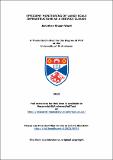Files in this item
Efficient monitoring of large scale infrastructure as a service clouds
Item metadata
| dc.contributor.advisor | Barker, Adam David | |
| dc.contributor.author | Ward, Jonathan Stuart | |
| dc.coverage.spatial | viii, 199 p. | en_US |
| dc.date.accessioned | 2015-07-13T15:36:07Z | |
| dc.date.available | 2015-07-13T15:36:07Z | |
| dc.date.issued | 2015 | |
| dc.identifier.uri | https://hdl.handle.net/10023/6974 | |
| dc.description.abstract | Cloud computing has had a transformative effect upon distributed systems research. It has been one of the precursors of supposed big data revolution and has amplified the scale of software, networks, data and deployments. Monitoring tools have not, however, kept pace with these developments. Scale is central to cloud computing but it is not its chiefly defining property. Elasticity, the ability of a cloud deployment to rapidly and regularly change in scale and composition, is what differentiates cloud computing from alternative paradigms of computation. Older tools originating from cluster, grid and enterprise computing predominantly lack designs which allow them to tolerate huge scale and rapid elasticity. This has led to the development of monitoring as a service tools; third party tools which abstract the intricacies of the monitoring process from the end user. These tools rely upon an economy of scale in order to deploy large numbers of VMs or servers which monitor multiple users’ infrastructure. These tools have restricted functionality and trust critical operations to third parties, which often lack reliable SLAs and which often charge significant costs. We therefore contend that an alternative is necessary. This thesis investigates the domain of cloud monitoring and proposes Varanus, a new cloud monitoring tool, which eschews conventional architectures in order to outperform current tools in a cloud setting. We compare a number of aspects of performance including monitoring latency, resource usage and elasticity tolerance. Through investigation of current monitoring approaches in conjunction with a thorough examination of cloud computing we derive a design for a new tool which leverages peer to peer and autonomic computing in order to build a tool well suited to the requirements of cloud computing. Through a detailed evaluation we demonstrate how this tool withstands the effects of scale and elasticity which impair current tools and how it employs a novel architecture which reduces fiscal costs. We demonstrate that Varanus maintains a low, near 1 second monitoring latency, regardless of both scale and elasticity and does so without imparting significant computational costs. We conclude that this design embodied by this tool represents a successful alternative to current conventional and monitoring as a service tools. | en_US |
| dc.language.iso | en | en_US |
| dc.publisher | University of St Andrews | |
| dc.subject.lcc | QA76.585W2 | |
| dc.title | Efficient monitoring of large scale infrastructure as a service clouds | en_US |
| dc.type | Thesis | en_US |
| dc.contributor.sponsor | Large Scale Complex IT Systems (LSCITS) | en_US |
| dc.type.qualificationlevel | Doctoral | en_US |
| dc.type.qualificationname | PhD Doctor of Philosophy | en_US |
| dc.publisher.institution | The University of St Andrews | en_US |
This item appears in the following Collection(s)
Items in the St Andrews Research Repository are protected by copyright, with all rights reserved, unless otherwise indicated.

